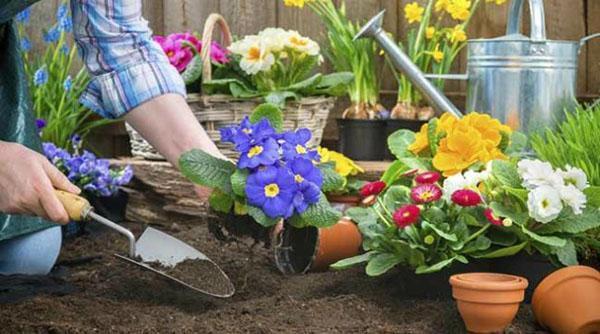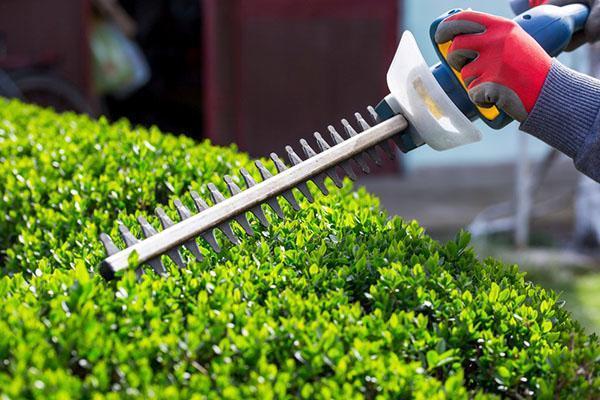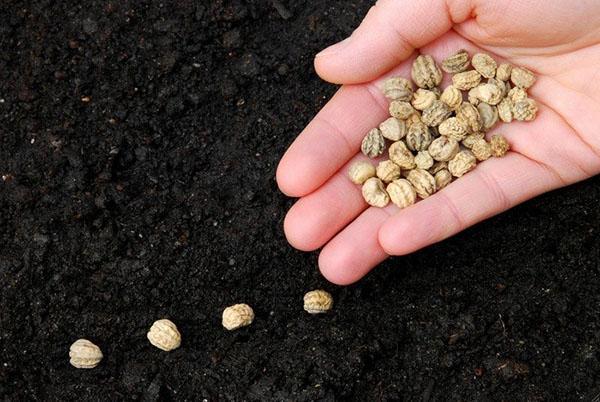May in flower beds: a contribution to future beauty
 April was a month of general cleaning for lovers of ornamental garden plants. May is the time to return the beauty to the flower beds by sowing new annual flowers, dividing and planting existing perennials, planting bulbs and tackling seedlings tightly. We must not forget about the splendor of the lawn that has lost over the winter, as well as about hedges and ornamental shrubs.
April was a month of general cleaning for lovers of ornamental garden plants. May is the time to return the beauty to the flower beds by sowing new annual flowers, dividing and planting existing perennials, planting bulbs and tackling seedlings tightly. We must not forget about the splendor of the lawn that has lost over the winter, as well as about hedges and ornamental shrubs.
First of all, what was started in April should be completed:
- to remove foliage and dead stems on the flower beds with perennials remaining under the snow;
- remove shelters;
- to carry out sanitary and rejuvenating pruning of shrubs, until the opening of flower buds and the appearance of foliage begins.

Sowing summer plants in the ground and planting seedlings
 The first half of May is the best time for sowing annual flower crops in the ground. But since the weather can present unpleasant surprises in the form of cold rain, wind and frost, the species should be selected taking into account their frost resistance.
The first half of May is the best time for sowing annual flower crops in the ground. But since the weather can present unpleasant surprises in the form of cold rain, wind and frost, the species should be selected taking into account their frost resistance.
Such plants include decorative sunflowers and cornflowers, calendula, morning glory and annual delphiniums, mattiola and poppies, lavater and sweet peas, the seeds of which should be germinated a little before planting.
Since the transplantation of these plants is not expected, they are immediately sown in flower beds, according to the chosen plan. It is easy and convenient to do this when places for each of the species are marked on the prepared site using sawdust, sand or crushed chalk.
Large seeds are sealed one at a time, and small ones are first mixed with sand for convenience, and then sown in prepared rows. With systematic care and watering, friendly seedlings quickly rise and cover the flower bed with a lively bright carpet.
Planting flower seedlings in open ground also begins with cold-resistant plants, and by the middle of the month, when the main frosts are behind, you can take out all crops to the site, without exception. Young plants grown at home, even when hardened, in the open air experience some stress. Until rooting occurs, within 7-14 days after transplanting, it is better to artificially shade the flowers during the daytime and cover them at night if there is a risk of recurrent cold weather.
 It is convenient to do this using a nonwoven material, which, depending on the selected density, can:
It is convenient to do this using a nonwoven material, which, depending on the selected density, can:
- protect against cold snaps down to –6 ° C;
- smoothes sunlight during the day and prevents overheating of seedlings;
- does not create a greenhouse effect and condensation;
- transmits the useful spectrum of sunlight and moisture.
Both the seedlings of ornamental plants and the seedlings need a regular supply of moisture.
Inhabitants of flower beds, borders and ridges, hanging baskets must be watered in dry weather. This should be done extremely carefully, at the root, in the evening hours, when the air is quietest and there is no danger of sunburn.
To save energy and water, mulching is used. Here, the gardener will be helped not only by peat, but also freshly cut from the growing lawn and chopped grass.
May landing and reproduction of perennials
 The last month of spring is the best way to decorate the garden with new perennials, transplant existing ones and divide large specimens.For such an important work requiring attention, they choose a quiet, cool day.
The last month of spring is the best way to decorate the garden with new perennials, transplant existing ones and divide large specimens.For such an important work requiring attention, they choose a quiet, cool day.
If the sun is even partially obscured by clouds, the transplanted plants will find it easier to acclimate. And the grower will have more confidence that the roots during transplantation will not suffer from drying out.
At the beginning of the month, especially with the unhurried arrival of spring, adult plants of phlox, chrysanthemum, astilbe and perennial delphiniums... Faded in pot culture primroses in May can be transferred to the garden, for example, in the trunks of fruit trees cleared of weeds or on flower beds broken in the shade.
 Until the active growth of the aboveground part begins, you can dig up and divide perennial asters, heuchera, lichnis, all kinds and varieties of chamomile, rudbeckia and echinacea. If you do this work in May, young plants take root well, and with regular watering, weeding and feeding, they even bloom at the usual time.
Until the active growth of the aboveground part begins, you can dig up and divide perennial asters, heuchera, lichnis, all kinds and varieties of chamomile, rudbeckia and echinacea. If you do this work in May, young plants take root well, and with regular watering, weeding and feeding, they even bloom at the usual time.
If new plants are to be planted, flower growers often face the fact that rose bushes, hydrangeas, ornamental shrubs, daylilies, various types of lilies and other crops, the growing season has already begun. Sometimes such perennials get to the site already with buds. In order not to lose a valuable acquisition, after planting, the plant is equipped with protection from possible frost, rain and wind.
Bulbous crops in May
 Spring bulb crops are the main decoration of the garden in May. During flowering, they require watering, which continues for another two weeks after the removal of wilted tulips, daffodils, muscari, hyacinths.
Spring bulb crops are the main decoration of the garden in May. During flowering, they require watering, which continues for another two weeks after the removal of wilted tulips, daffodils, muscari, hyacinths.
It is important to soak the soil under tulips, daffodils and hyacinths about 20 cm so that the bulbs have time to accumulate enough nutrition, and in August they again fall into the ground completely ready for wintering and future flowering.
In addition, the first half of May is the time to plant gladioli in the ground. The ridges for them are prepared in the fall, and the corms themselves:
- in the spring they warm up and germinate;
- remove integumentary scales;
- damaged or mold-affected specimens are separated from the planting material.
 Planting is carried out at a distance of 15–20 cm, in sunny areas protected from cold winds.
Planting is carried out at a distance of 15–20 cm, in sunny areas protected from cold winds.
Mowing hedges and keeping your lawn tidy
 Hedges are sheared throughout the warm season, but in spring this procedure is most important. When deciduous shrubs awaken from their winter sleep, it becomes clear how they got through the winter. Therefore, cutting is combined with sanitary pruning, renewal of plantings and uprooting of dead plants.
Hedges are sheared throughout the warm season, but in spring this procedure is most important. When deciduous shrubs awaken from their winter sleep, it becomes clear how they got through the winter. Therefore, cutting is combined with sanitary pruning, renewal of plantings and uprooting of dead plants.
Held in May lawn aeration, its regular shearing begins, and also, if necessary, sowing of new grass is carried out in the place of the thawed out or frozen. To keep the grass cover thick and green all summer long, the lawn is fed. Also in May, it is best to lay new lawns, not only of the classic style, but also the popular Moorish lawns today.